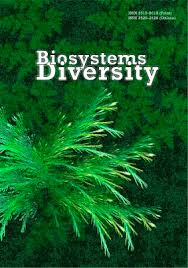Asymmetric hybridization of roach Rutilus rutilus and common bream Abramis brama in controlled backcrosses: Genetic and morphological patterns
Asymmetric hybridization of roach Rutilus rutilus and common bream Abramis brama in controlled backcrosses: Genetic and morphological patterns
Author(s): V. V. Stolbunova, V. V. Pavlova, Y. V. KodukhovaSubject(s): Energy and Environmental Studies, Sociobiology
Published by: Дніпропетровський національний університет імені Олеся Гончара
Keywords: backcrosses; Cyprinidae; introgression of mtDNA; morphological analysis; nuclear-cytoplasmic incompatibility;
Summary/Abstract: In most cases in natural environments, hybrids of roach Rutilus rutilus L. and bream Abramis brama L. possess mitochondrial DNA of bream. Presumably, the genetic basis for unidirectional hybridization of roach and bream is the high level of divergence in the genes of the mitochondrial electron transport chain (cytochrome b and cytochrome c oxidase subunits I, III). Disruption of the interaction of the products of these genes leads to nuclear-cytoplasmic incompatibility of alien genomes, what is shown in a decrease of viability and developmental abnormalities in hybrids. In the present work we studied the viability and morphology of hybrid underyearlings obtained by crossing of hybrid females of first generation (RA and AR) with males of roach R. rutilus and bream A. brama. The method of genotyping (ITS1 ribosomal DNA, cytochrome b mtDNA) and comparative analysis of the complex of 23 plastic and meristic characteristics of backcrossed hybrids are used. All progenies showed an increase in morphological variability compared to parental species and F1 hybrids. In progenies with introgression of mtDNA, a violation of associations between traits and the formation of transgressive phenotypes that go beyond the parental populations were found. In RAA backcrosses (combining mtDNA of R. rutilus and nuclear genome of A. brama) a decrease in viability with impaired recovery of external traits of bream was found. Conversely, ARR backcrosses (combining mtDNA of A. brama and the nuclear genome of R. rutilus) have a high viability and completely restore the morphotype of roach, which indicates the stable development of hybrids when they include alien genetic material. The differences in viability and morphology between backcrossed hybrids with the mtDNA of R. rutilus and A. brama evidence varying degrees of nuclear-cytoplasmic compatibility of the genomes of roach and bream. The complete interaction between mitochondrial and nuclear DNA from different species (wild-type-like) happens in direction of introgression mtDNA of A. brama, the less polymorphic of the two parental genomes. In the direction of introgression of highly polymorphic mtDNA of R. rutilus the formation of a reproductive barrier occurs. Our results show that the main reason for the asymmetry of hybridization of R. rutilus and A. brama is unequal rates of mitochondrial evolution and the priority of the introgression of mtDNA belongs a species with a lower rate of changes in mtDNA.
Journal: Biosystems Diversity
- Issue Year: 28/2020
- Issue No: 4
- Page Range: 376-383
- Page Count: 8
- Language: English

